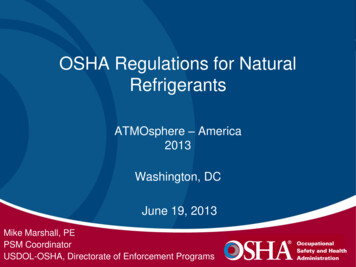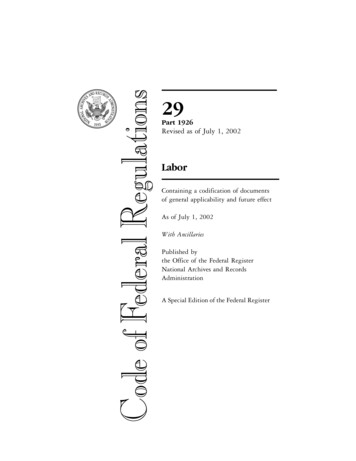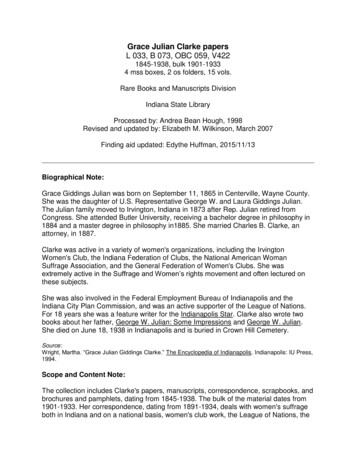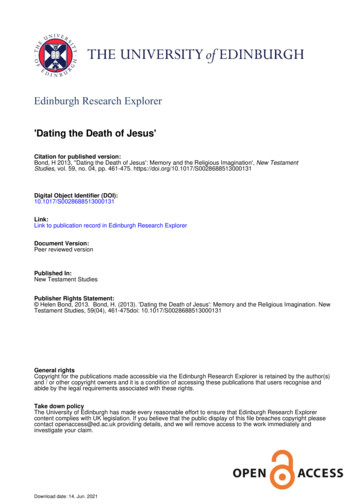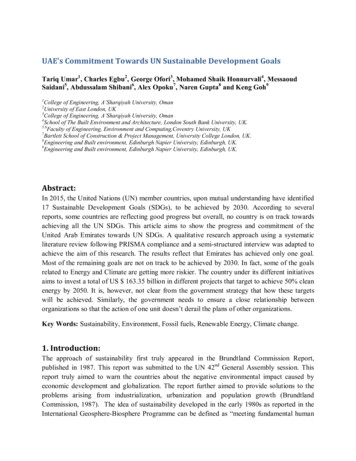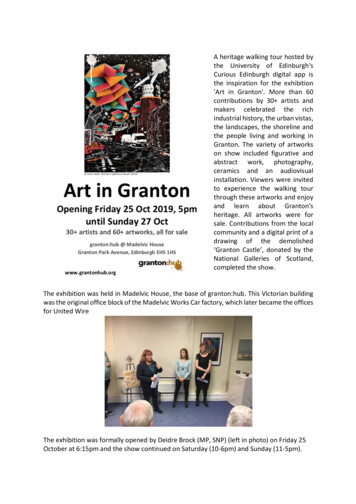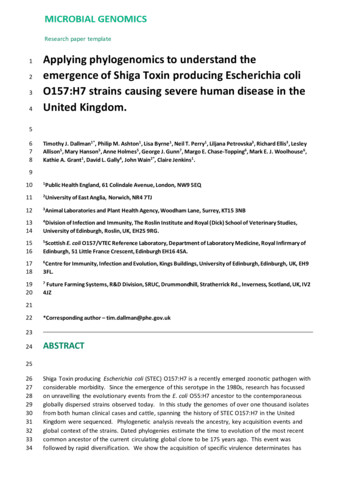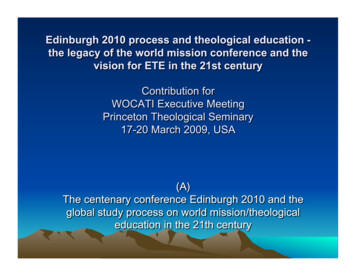
Transcription
Edinburgh 1910 – origin of theglobal ecumenical movement 1200 delegates from 150 mission societies andchurches, only 17 representatives from socalled„mission fields“ Sense of urgency for world evangelization „theevangelization of the world in this generation“(John R.Mott and J.H. Oldham) Protestant and anglosachson dominance, absence ofroman-catholic and orthodox representatives 8 sections dealing with world mission priorities for the20th century; focus on ecumenical unity for commonworld mission (section 8) Appointment of continuation committee which led tothe launching of IRM (1912) and the formation of IMCin Lake Mohonk, NY (1921) Subsequent formation of Faith and Order Movement(1927 in Lausanne) and Universal Christian conferenceon Life and World (1925)
Edinburgh 1910 – emergence of a commonconcern for christian education Edinburgh 1910 as the culmination of the optimistic spirit of the great missionary enterprise of19th century Christianity in the North-Atlantic. The assumption being that a goal like„evangelization of this world in one generation“ could be a common, feasible and practical shortterm aim and „Christian forces“ around would be enough to be assembled for that purpose. It alsowas the still unchallenged assumption that countries in the East and the South had to graduallyadapt and be upgraded to the systems of civilization, Christianization and education which weredeveloped in the „Christian west“ (two different messages!) New attention to the importance of education: Key concept of „moral education of the people ofthe South“:“Moral education” referred to the religious and spiritual education of the masses in countries theSouth which only by education could be safeguarded against the negative side-effects of theencounter with western modernization and technological revolution for the understanding of thattime: „One of the striking phenomena of the present hour is the worldwide recognition of thenecessity of the moral, if not the religious, element in education – a recognition by no meansconfined to Christian nations, but found also among the Hindus of India, the Confucianists inChina, and the statesmen and educators in Japan trained in the precepts of Bushido With duerecognition of the many elements of truth and value in the non-Christian systems of religion andethics, we should nevertheless be faithless if we did not at this time reaffirm our conviction thatthe education of the world demands for its highest and best developments of those elements oftruth which are the peculiar contribution of Christianity to the world’s though and life.“(EW III, 368).Or also: „The impact of western civilization upon the peoples of Africa, with the disintegrating andoften demoralizing influences that seem to accompany it, imposes on Christian nations, who haveaccepted responsibilities in relation to the native races, a binding obligation to provide a new,moral and religious foundation for social life in place of the old sanctions which have beendestroyed.“(ebd. S. 379)Key vision of Edinburgh 1910 that religious education should be strenghthened in order to helpcounterbalancing the ambivalent side-effects of western modernization for the countries of theSouth.
Edinburgh 1910 – emergence of a commonconcern for theological education Commission V in the Edinburgh 1910 world mission conference was dealing with questions of the„preparations of the missionaries“. It was the first time that the idea emerged and was articulatedby a common Christian forum for the establishment of new forms of centralized and ‚ecumenical’education of future missionaries. Until Edinburgh 1910 the majority of missionaries were trained at seminary level, only inexceptional cases like Danish-Hallesche Mission in the 18. century missionaries were they alsotrained at an academic level. In reviewing existing mission seminaries and facilities for training, Edinburgh 1910 came to theconclusion that the education of missionaries needed to be drastically improved in terms of botha) language studies, b) history of religions and sociology of mission territories and c) in generalprinciples of missionary work. Interdenominational cooperation of mission agencies for common training programmes formissionaries was seen as the priority for the future in Edinburgh 1910. Missionary trainingprogrammes were recommended to be upgraded academically to post-graduate levels and totake place mainly in „central missionary colleges“ (not as before just in regional denominationalmission seminaries) which were to be foreseen in places like Shanghai, Madras, Calcutta, Beirutand Kairo and should be open to missionaries of all Christian denominations. These plans were visionary and revolutionary in their understanding of Christian education andtheological education in particular. Without using the terminology yet this can be seen as thebirthplace of a global initiative for centralized places of academic ecumenical theologicaleducation in various key centres outside the western world to train indigenous clergy andtheological educators.The paved the way for the foundation of TEF in 1958 which was given birth to within the IMC.
After Edinburgh 1910 – different streams ofcommitment for ecumenical theologicaleducation 1946 founding of Bossey Ecumenical Institute as focal point for ecumenical programms fortheological education for clergy and lay people1947 founding of World Council of Christian Education (originally World Sunday SchoolConvention which existed since 1889)1958 foundation of Theological Education Fund in London Bromley with three decisive goalsfocussing on––– - Quality of TE combining intellectual rigour, spiritual maturity and commitment- authenticity of TE involving critical encounter with each cultural context in the design, purpose and shapeof theological education- creativity of TE, understood as promoting new approaches of the churches obedience in mission.Three Mandate periods of TEF:- Mandate period 1958-1965: emphasis on indigenous and interdenominational places andinstitutions for theological education in the South- Mandate period 1965-1970: emphasis on new curricula developments for the churches of theSouth and new teaching materials written by leading theologians from the South- Mandate period 1970 to1977: critique over against western concepts of theological educationand major calls for contextualization of both forms of ministry and forms of theological educationin the South. 1969 establishment of an office for Education in WCC after Uppsala focus on liberating patternsof education (Paulo Freire, Ernst Lange, Ivan Illich) 1971 integration of World Council of Christian Education into WCC 1977 formation of the PTE-program of WCC (Samuel Amirtham from TTS Madurai)1992 formation of ETE-progam
Changes in the landscape of globalChristianity since 1910 Growth of Christian churches in the Southern hemisphereDe-colonialization and growing independence of churches in the SouthFormation of regional ecumenical organizations in the SouthShift of the center of gravity of Christianity to the global Southloss of credibility and self-confidence of western Christendom after twoworld warsEmergence of independent institutions of theological education in countriesof the SouthPluralization of Christianity and ongoing denominational fragmentationEmergence of new churches and Christian movements beyond thehistorical mission churchesPluralization of major ecumenical players in the ecumenical movement(WCC not any more being the only player)Emergence of a movement for a „wider ecumenism“ due to interfaithrealities in Asia which moves beyond some of the forms of historicalecumenismIncreasing need to re-formulate a common understanding of mission andprioirity mandates for theological education for Christianity in the 21stcentury
The project of the centenaryconference 2010 Vision:The forthcoming Centenary of the World Missionary Conference held in Edinburgh1910 is proving to be a suggestive moment for many people who are seekingdirection for Christian mission in the 21st century. Several different constituencieswithin World Christianity have begun to plan significant events in 2010. Since 2005 aninternational group has worked collaboratively under the aegis of Edinburgh 2010.This intercontinental and multi-denominational project, now known as EDINBURGH2010, is based at New College, Edinburgh, and headed by an International Director,Dr Daryl Balia. Governance:It is governed by a 20 member General Council with representatives of the majorityChristian families, composed of 20 people representing the following memberorganizations:(a)(b)(c)major groupings planning international missional events around 2010;church associations involved in common missional conferences around 2010;global mission networks;
The project of the centenaryconference 2010Goals:Churches will be provided with an opportunity to celebrate what God has done in the growth ofthe Church worldwide over the past century and to prayerfully commit to God the witness of thechurches in the 21st Century The biblical call to mission will be affirmed and articulated within our contemporary contextswith particular focus on the meaning of evangelization and relevance of Christian witness today A key conversation on mission will be initiated with mission leaders from the older missionmovements of the North and the new mission movements from the South and East, withdialogues held among representatives of different Christian traditions Guidelines will be developed and studies published to help church and mission leaders evaluatefor their own situation models of mission which are proving effective elsewhere Based on a critical assessment of the status of the world, a new vision of God's purposes forcreation in Christ and a renewed spirituality and mission ethos will be developed in the life ofthe churches worldwide. Centenary celebrations of mission in humility and hope will be held throughout the world with theAssembly Hall in Edinburgh, again, being the venue from 2- 6 June 2010 for the historiccelebration involving over 700 delegates.
Themes of the global Edinburgh 2010 studyprocesses THE 2010 MISSION THEMESEssential to the work of the Edinburgh 1910 Conference, and of abiding value, were the findings of the eight thinktanks or ‘commissions’. These have inspired the idea of a new round of collaborative reflection – but focussed onthe themes identified as being key to mission in the 21st century. A small but widely representative consultationheld in Edinburgh in June 2005 identified key themes and these were further developed in subsequent rounds ofemail discussion. 1) - Foundations for Mission2) - Christian mission among Other Faiths3) - Mission and Post-modernity4) - Mission and Power5) - Forms of missionary engagement6) - Theological education and formation7) - Christian communities in contemporary contexts8) - Mission and unity – ecclesiology and mission9) - Mission spirituality and authentic discipleshipTRANSVERSALS- Women and Mission- Youth and Mission- Healing and Reconciliation- Bible and Mission- Contextualization- Subaltern Voices- Ecological Insights
Edinburgh 2010 – international studygroup on theological education Global challenges for theological education today: a) There are still grave discrepancies in the availability and accessibility of higher theological education inmany countries with fast growing churchesb)interdenominational colleges and centers of excellency in theological education have more difficultiesto become financially self-reliant and viable then ever before;c)there is a mushrooming of new colleges and bible schools in many regions many of which have noexperience or connection to the global Christian family;d)many churches as well as funding organizations in developmental work still do not give proper priorityimportance to theological education in their budget plans; e)the international lobby for promoting and funding programs of theological education has remained orbecome small in many churches, networks, funding agencies or in interdenominational and ecumenicalorganizations;f)globalization of economy and the continuous brain drain of highly trained theologians from countries ofthe South to countries of the North deepen the problem of glaring discrepancies in the availability of properexpert and library resources for theological education;h)rapidly changing political scenarios on national and global level and increasing tensions betweenChristianity and other world religions demand for much higher commitment to interreligious dialogue(particularly of Christian-Muslim dialogue) and expertise in new frontier issues of ethics (bio-ethics, ecologicalethics, sexuality ethics and communication ethics) than most of the curriculum plans of institutions oftheological education prepare for;i)the resurgence of fundamentalism and confessionalism as counter-movements to the pressures ofglobalization demand for an even deeper commitment for mutual dialogue, cooperation andinterdenominational unity by all participants in theological education – despite the dwindling of funds andfinancial resources.
Edinburgh 2010 – international studygroup on theological education Goals for the study group on theological education: a) to analyze major global challenges and trends in theological formation andeducation on a global scale today;b) to provide one major historical study on how theological education in churchesparticularly of the southern hemisphere emerged and was shaped during the past 100years of the missionary movement;c) to consider preparing some short regional surveys on the actual stage oftheological education in five different regions (Asia, Africa, Pacific, Eastern Europe,Latin America);d) to outline some basic theological foundations for the interrelation betweentheological formation, mission and the commitment to church unity of the universalchurch in the broadest sense of these terms;e) to describe some key insights of relevant new (missionary) renewal movements fortheological education in its different forms;f) to define some overarching key goals for developing and nurturing theologicaleducation and the viability of institutions of theological education in the 21st century;g) to propose some key actions or new models of cooperation for mechanisms ofglobal solidarity of theological education for the Edinburgh 2010 follow-up processbetween the different “families” acting more or less separately in the area oftheological education until today (ecumenical, evangelical, Pentecostal);
Projects of the international studygroup on theological eudcation 1) Summary study report paper to beavailable by September 2009 on the futureof theological education in the 21st century 2) Global Handbook on Theologicaleducation 3) Regional TE-Resource Books forTeaching Ecumenism
Outline of Summary Study Report Paper I Edinburgh 2010 – international study group on theological educationsummary study report paperTentative working draftBossey 3rd December 2008 I) Foundations and Clarifications1) Missionary training and theological education in Edinburgh 1910 and majorachievements since then – historical review 2) Theological education and ministerial formation – clarification of terms 3) Theological education and christian mission – biblical and missiological insights 4) Theological education and the church – a relationship of service, ownership and criticaldistance 5) Theological education and different understandings of the Bible – re-reading the Bibletoday, importance of Biblical hermeneutics in TE 6) Theological education and the unity of the church – interdenominational cooperationand ecumenical learning in TE 7) Diversity in theological education and the different forms of ministry in the church 8) Theological education and a missionary spirituality – spiritual formation in TE 9) Women in theological education and new approaches in women’s theological networks
Outline of Summary Study Report Paper II II) Contexts and Case Studies 10) Interdenominational institutions of theological education – United Theological colleges– promises or failures? 11) Theological training programs for migrant churches (Queens Foundation and others) 12) Short term mission training programs (CWM and others) 13) Reconstructing churches by reconstructing theological education – a case study on TEin China 14) Fragmentation and pluralization in TE – a case study on TE in Myanmar 15) New accreditation criteria and the quality of TE – a case study on TE in South Africaand in other contexts 16) Pentecostalism and TE – a case study on the interrelation between pentecostalmovement, theological education and the ecumenical movement 17) The role of regional centers of excellence in theological research and studies – a casestudy of SEAGST program 18) Structural divides and potentials for cooperation in networks of TE – a case study onthe interrelation between BTESSC and ATA (ecumenical and evangelical associations)
Outline of Summary Study Report Paper III III) Affirmations and Recommendations 19) On TE and mission education 20) On different structural settings and models for TE (church semionaries, private bibleschools, state theological faculties ) 21) On the churches support and ownership for institutions of theological education 22) On global solidarity in theological education 23) On innovative models of traning for (cross-cultural) mission and intercultural formation 24) On interfaith-learning in theological education 25) On the unity of the church in theological education 26) On new models of online-education and e-learning in theological education 27) On financial viability and global financial support for theological education IV) Concluding service part28) Selected new websites of important networks of theological education 29) Selected bibliography on global theological education 30) Major regional associations of theological education
Is „ecumenism“ on cooperation betweenprotestants and catholics? Is „ecumenism“ on the unity of the church? Is „ecumenism“ on the wholeness ofhumankind? Is „ecumenism“ on the merging of all worldreligions? Is „ecumenism“ an anti-christian conceptand a threat to true Christian faith?
The origin of the English word ecumenical is the ancient Greek oikoumene.The root of this word is oikos, a house, and its original meaning relates tothose who live together in a household. By a process of extension it cameto refer to the whole inhabited earth. This is a similar journey to thatundertaken by another word coming from the root of oikos, economy, whichbegan as the management of the household. The New Testament uses the word oikoumene (oikoumenh) in the sense ofthe whole inhabited earth in several places. To give some well knownexamples: In those days a decree went out from Emperor Augustus that all the world(oikoumenh) should be registered. (Luke 2.1 NRSV) Then the devil led him up and showed him in an instant all the kingdoms ofthe world (oikoumenhz). (Luke 4.5 NRSV) And this good news of the kingdom will be proclaimed throughout the world(oikoumenh), as a testimony to all the nations; and then the end will come.(Matt 24.14 NRSV)
The word “ecumenical” acquired its ecclesiastical connotationsthrough the name being applied to the early councils of the churchfrom the Council of Nicea in 325. Although it can be argued that these councils contained a variety ofpractice and belief, the term ecumenical was applied because theybrought together representatives of Christian communities fromaround the then known world. A council called by the Roman emperor was de facto anauthoritative body. The word ecumenical when applied to Nicea andsubsequent councils became associated with that which isauthoritative and valid throughout the whole church. An ecumenical council becomes understood as a body whichspeaks on behalf of the whole church.
The 1910 Edinburgh Missionary Conference, from which the modernecumenical movement is often dated, was entitled Third EcumenicalMissionary Conference in it early planning stages. The ecumenicaldescription was dropped because neither the Roman Catholic orOrthodox churches would be present and that it was a deliberativerather than legislative event. At the conference that constituted the Evangelical Alliance in 1846,several speakers used the word ecumenical in the sense of commonbelonging and attitude rather that in the traditional sense. Henri Dunant, remarkable founder of the Red Cross in 1863 and apioneer of the YMCA, constantly stressed the need for an“ecumenical spirit”, defining “ecumenical” as:“that Christians of different denominations can and must unite inlove, associate with each other, and work together in charity for theglory of God, while maintaining their individual liberty and even theirright to defend, if necessary, but with tolerance and charity, theirpersonal points of view and their particular religious convictions.”
Faith and Order Movement:Emphasis on the visible unity of the church Life and Work Movement:Emphasis on the wholeness, peace and reconciliation,of the human family Missionary Movement:Emphasis on the holistic mission of the church in theworldComment of Stephen Neill (reviewing the history of the ecumenical movement up to 1948) :“One of the chief problems in the ecumenical movement in the mid-20th-century was thatoccasioned by the separation between its two essential components. This history hasshown at point after point the intimate connection between the missionary work of thechurch and the ecumenical ideal. Throughout the world, ecumenical has been used todesignate the efforts of Christians to seek and promote unity but it should now be plainto the reader that these efforts are not an end in themselves. The aim of Christian unionis that the world may believe.”
Central Committee of the World Council of Churches, Rolle, 1951:“It is important to insist that this word which comes from the Greek word forthe whole inhabited earth, is properly used to describe everything thatrelates to the whole task of the whole church to bring the Gospel to thewhole world. It therefore covers equally the missionary movement and themovement towards unity, and must not be used to describe the latter incontradistinction to the former. We believe that a real service will berendered to true thinking on these subjects in the churches if we so use thisword that covers both unity and mission in the context of the whole world.” WCC Assembly, New Delhi, 1961:“We believe that the unity which is both God’s will and his gift to his Churchis being made visible as all in each place who are baptized into Jesus Christand confess him as Lord and Saviour are brought by the Holy Spirit into onefully committed fellowship, holding the one apostolic faith, preaching the oneGospel, breaking the one bread, joining in common prayer, and having acorporate life reaching out in witness and service to all and who at the sametime are united with the whole Christian fellowship in all places and all agesin such wise that ministry and members are accepted by all, and that all canact and speak together as occasion requires for the tasks to which Godcalls his people.”
Philip Potter addressing the Central Committee in 1977:“The whole burden of the ecumenical movement is to co-operate with God in making theoikoumene an oikos, a home, a family of men and women, of young and old, of varied gifts,cultures, possibilities, where openness, trust, love and justice reign”(1) Philip Potter adressing the Vancouver Assembly in 1983, drawing on the image of livingstones being built into a spiritual house in 1 Peter 2:“But becoming living stones means that believers and communities of believers do notremain isolated, alone, petrified, dead. They are made alive and are being built into ahouse, an oikos which is enlivened by the spirit. Christ is the cornerstone, and the spiritenables those who come to Christ to be built into this house The ecumenical movement is, therefore, the means by which the churches which form thehouse, the oikos of God are seeking so to live and witness before all peoples that thewhole oikoumene may become the oikos of God through the crucified and risen Christ inthe power of the life-giving spirit.”The fellowship of churches within the WCC therefore is a community of ecumenicallearning about what it means to be the one learning community of confessing, learning,participation, sharing, healing, reconciliation, unity and expectancy.(2) [1] Philip Potter, One Obedience to the Whole Gospel, in The Ecumenical Review, Vol 24, No 4,October 1977 p303[2] Philip Potter, A House of Living Stones, in The Ecumenical Review, Vol 35, No 4 October 1983pp352 & 354
Different historical contexts for the development of the ecumenical movement in the West and in Asia:A) Western countries: the shock of aggressive nationalism, destructive politization of Christianity and therediscovery of liberating internationalism and the interdenominational unity of the churches – emphasis onecclesial and social ecumenismB) Asian countries: the emergence of a liberating nationalism over against western domination andimperialism; rediscovery of the unity of the whole people – emphasis on people’s ecumenism and interfaithecumenism, wider ecumenism Examples for Asian accents on a wider ecumenism:1) Stanley J Samartha:“With a broadening awareness of the world perspective of religious pluralism today and with several worldorganisations seeking a greater measure of corporation the time has come to search for a new style ofecumenism encompassing the whole of humanity, but which recognises within itself the creativeparticularities of pluralism.(Stanley J Samartha, Courage for Dialogue, Ecumenical Issues in Inter-religiousrelationships, Geneva, WCC, 1981 p343 2) Raymondo Panikkar:Calling the traditional understanding of ecumenism ‘Christian ecumenism’ and looking for an ‘ecumenicalecumenism’, Panikkar comments: Christian ecumenism if it is really to be ecumenical cannot be reduced tosettling Christian family feuds as if it were for healing old wounds. It has also to take into account of theentire world situation and find a place of religions of the world in this without a priori subordination of otherreligions to the Christian self-understanding (Raymondo Panikkar, ‘Towards an Ecumenical Ecumenism’, inJournal of Ecumenical Studies, Fall, 1982 pp764f) 3) Ahn Jae Woong, GS of Christian Conference of Asia: international symposium in 2002 on the theme ofthe new ecumenism.“I prefer to emphasise this wider meaning through three coined words – theo-ecumenics, eco-ecumenicsand geo-ecumenics. By theo-ecumenics I mean that our ecumenical mission should have a theocentricemphasis on God the source and creator, protector and liberator of the world. By eco-ecumenics I meanthat our ecumenical mission should be eco-friendly and must involve the whole of God's creation. By geoecumenics I mean that our ecumenical task should be geo-contextual - where Asia’s unique plurality ofreligions, cultures, races, languages, a peoples, creeds, and colours are affirmed and help to flourish”
1900 Madras: First Asian regional mission conference: example for Edinburgh1907 WSCF conference in Tokyo – first international ecumenical conference to beheld in the « East » (‘orientation’ of the federation) (627 participants)1910 Edinburgh world missions conference: fameous speech of V.S. Azarajah ofIndia, « the first shot in the campaign against missionary imperialism » (1200delegates, 17 of the South)Asian national YMCA conferences (e.g.China, Shanghai 1913)WSCF international Asian conference in Peking 1922: need for indigenous and selfpropagating churches in Asia1928 IMC Conference Jerusalem: relation between older and younger churches1933 Asiatic Asia WSCF conference in Java (Indonesia): critique of westernimperialism and loyality of Christians to the newly emerging Asian nations1938: Tambaram IMC conference: the Christian message and its relation to people ofother faiths1955: Bandung (Indonesia): first international conference of independent nations ofAsia and Africa1957: Parapat: First conference of East Asian Christian Conference (EACC):Christians in Asia are no longer mission fields and objects of Western mission bodies,but they stand together for their own witness in Asia: The birth of Asian ecumenismKey point: Often the western missionary movement is depicted as the driving forcebehind the emergence of the modern ecumenical movement. But the unique andearly contributions of Asian Christians towards forming the ecumenical movement –out of protest against western domination and out of faithfulness to the call for theunity of the church – is often neglected and sidelined. The Asian contribution towardsmodern ecumenism needs to be highlighed and rewritten in detail
Classical vision for Asian ecumenism: „First, ecumenism is churches in mutual dialogue with Christ. Asianecumenism should be understood essentially as the conversation ofthe churches in Asia among themselves and with the non-Asianchurches in Christ. This interchurch dialogue is necessary for mutualcorrrection and for a common discrimination of the Word of God fromhuman words. Second, ecumenism is liberation of the churches froman idolatrous attachment to outdated values and patterns of life whichare passing away. For Asia it means freeing the churches from thelegacy of Western Christendom, which was transferred to Asia in theperiod of western expansion inaugaurated by Vasco da Gama. Theend of these patterns in the relationship of church to state, sociaty,culture, and religions must become the hour of spiritual liberation of theAsian churches from the idols of that epoch. Third, the spiritualliberation from the bygone world and its idol
Until Edinburgh 1910 the majority of missionaries were trained at seminary level, only in exceptional cases like Danish-Hallesche Mission in the 18. century missionaries were they also trained at an academic level. In reviewing existing mission seminaries and facilities for training, Edinburgh 1910 came to the


